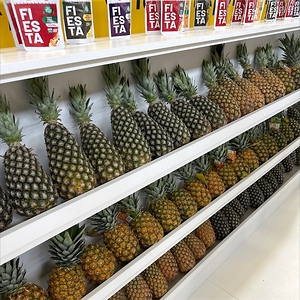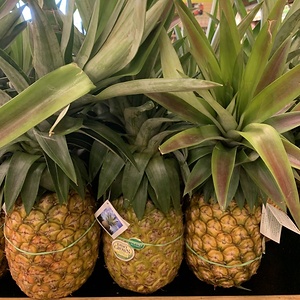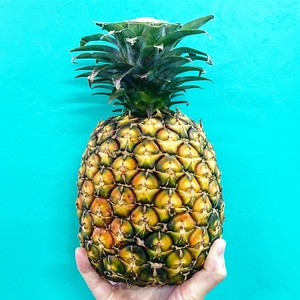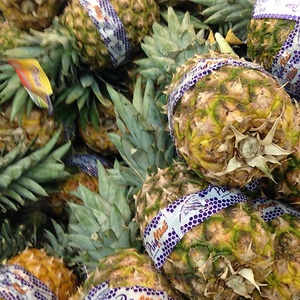

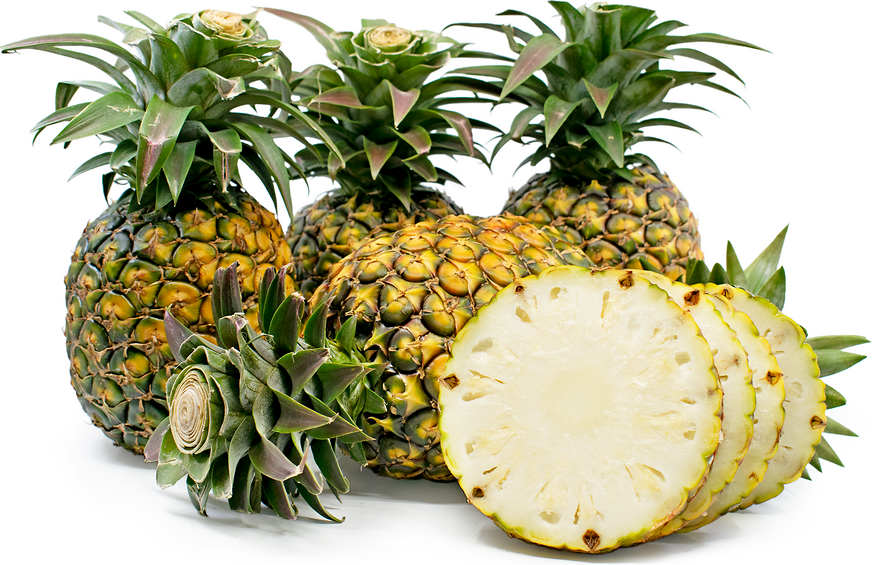
Sugarloaf Pineapples
Estimated Inventory, 10 ct : 0
Description/Taste
Sugarloaf pineapples vary in size and shape, depending on growing conditions, and range in appearance from round to elongated and slightly tapered. The variety averages 1.8 to 2.7 kilograms in weight when sold in markets and is topped with an extended crown of stiff, pointed, dark green leaves covered in tiny spines. The pineapple’s exterior is enveloped in a tough, waxy rind, and the surface has a bumpy texture created by the fusion of multiple hexagonal eyes. When ripe, Sugarloaf pineapples can remain green on their surface and are often golden yellow to orange at the center of each eye, while the edges stay a muted dark green. Underneath the surface, the white flesh is aqueous, soft, tender, and non-stringy. The core is also edible and is not woody or fibrous like other commercial pineapple varieties. Select Sugarloaf pineapples that are heavy for their size and release a floral aroma. Ripe Sugarloaf pineapples are known for their high sugar and low acidity, creating a sweet, fruity, and floral taste with vanilla, coconut, and honey nuances.
Seasons/Availability
Sugarloaf pineapples are available year-round, with a peak season from late spring through summer.
Current Facts
Sugarloaf pineapples, botanically classified as Ananas comosus, are a type of white-fleshed pineapple belonging to the Bromeliaceae family. The fruits grow on an evergreen, herbaceous perennial plant with an upright, tight rosette of spiny leaves. Sugarloaf pineapples are distinct from yellow-fleshed ones as they have a high sugar content and low acidity, creating a milder, sweeter taste without lingering tanginess. Sugarloaf pineapples are a specialty variety that is only grown in limited quantities worldwide. The variety is also known as Pain de Sucre in French, Pan de Azúcar in Spanish, and Hala Kahiki in Hawaiian. Other local names in English may include Bottle pineapples, Kona pineapples, and Brazilian White pineapples. Sugarloaf pineapples are primarily cultivated in West Africa and Hawaii and are valued for their versatility. Chefs and home cooks utilize the variety in a wide array of fresh or cooked and sweet or savory culinary preparations.
Nutritional Value
Sugarloaf pineapples have not been extensively studied for their nutritional properties. Pineapples, in general, are a source of vitamins A, C, and K to aid in faster wound healing, strengthen the immune system, and maintain healthy organ functioning. Pineapples also provide minerals like manganese, potassium, calcium, phosphorus, copper, and magnesium. Manganese helps the body produce collagen, while potassium balances fluid levels. Calcium and phosphorus support bones and teeth, copper assists in making red blood cells, and magnesium controls nerve functions. Other nutrients include fiber, folate, and zinc. Pineapples are said to have anti-inflammatory benefits and also contain bromelain, an enzyme that helps with digestion.
Applications
Sugarloaf pineapples have a mild, sweet, and tropical flavor suited for fresh and cooked preparations. The variety is valued for its sugar content and low acidity and is enjoyed out of hand. Sugarloaf pineapples can also be mixed into fruit salads, chopped into fresh condiments and slaws, or served as a fresh garnish. In Hawaii, Sugarloaf pineapples are blended and frozen into ice cream and sorbet-like treats. The pineapples are also incorporated into smoothies, juices, and mixtures for cocktails or thinly sliced, serving as a variation of carpaccio with lime juice and coconut pieces. In addition to fresh preparations, Sugarloaf pineapples are commonly added to desserts like cakes, puddings, and bars. The variety’s mild nature complements other caramelized fruits and is grilled and served with ice cream to develop a depth of flavor. Sugarloaf pineapples are also simmered into jams, jellies, syrups, and sauces. Beyond sweet dishes, the variety is added to rice-based dishes, curries, or poultry recipes. It is also chopped into salsa and toppings for seafood dishes like ceviche or grilled fish. Sugarloaf pineapples pair well with other tropical fruits like banana, coconut, or papaya, herbs like mint, Thai basil, and cilantro, and spices like cinnamon, paprika, ginger, and cayenne pepper. It is worth noting that pineapples ripen from the bottom up. To balance the sweetness throughout the fruit, remove the crown, then cover and store the fruit upside-down before use. Fresh Sugar Loaf pineapple is highly perishable and will keep at room temperature for just a few days. To extend its shelf life, store it in the refrigerator for up to a week or cut and freeze pieces for six months. Fresh, cut pieces can also be stored in the fridge in an airtight container for about three to five days.
Ethnic/Cultural Info
Sugarloaf pineapples are named after their resemblance to traditional sugarloaf cones. These solid, cone-like blocks of crystallized sugar were developed as early as the 15th century in Venice, Italy, and were also known as Venice cones. Sugarloaf cones were traditionally made during the final stage of the refining process and were created from a cone mold. Raw sugar was boiled with lime water to remove impurities. After this step, the mixture was combined with additional ingredients to purify the sugar, and the liquid was re-boiled, poured into cone-shaped molds, and cooled. After cooling, the sugar is wrapped in a layer of white clay slip to extract any lingering brown hues to create sugar’s signature white appearance. Sugarloaf cones were customarily sold in markets as they were easy to transport and had extended storage capabilities, remaining popular throughout the 18th century. The cones were such a cherished commodity, depending on their quality and price, that they were sometimes kept under lock and key in homes. These cones later inspired the name of the elongated white pineapples, especially when the fruits are sliced in half and showcase their white, tapered flesh, resembling a cone.
Geography/History
Sugarloaf pineapples are descendants of ancient varieties native to South America. These early species were used for culinary and medicinal purposes and were slowly spread throughout Central America and the Caribbean with migrating peoples and through trade. Over time, new varieties were selectively bred for improved cultivation. Pineapples were carried to the Old World sometime after the late 15th century and were planted in Spain, eventually expanding in cultivation in greenhouses throughout Europe. They were also established in Africa in the 16th century and later made their way to the South Pacific and Asia in the late 16th century. In the late 18th and early 19th centuries, pineapples were commercially planted in Hawaii. The history of Sugarloaf pineapples is unknown as there are heavily debated theories placing their origins in either West Africa or Hawaii. In the present day, the variety thrives in both West Africa and Hawaii, especially in Benin, Ghana, and Togo. In October 2021, Benin received the first protected Geographical Indication, or GI Tag, of West Africa for their Sugarloaf pineapples, a label recognizing the importance of the region’s climate in creating sweet-tasting fruits. Today, Sugarloaf pineapples are commercially cultivated on a small scale and are also grown in home gardens worldwide in tropical climates.
Recipe Ideas
Recipes that include Sugarloaf Pineapples. One
Podcasts



